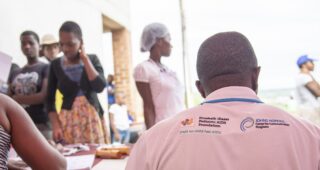EGPAF Ambassador Fátima Ptacek Interviews Dr. Warren Andiman
You are here
This is the second installment in a three-part blog series by EGPAF Ambassador Fátima Ptacek. The series will highlight three different facets of the global HIV/AIDS response: first, politics and policy; second, research and treatment; and third, advocacy and activism. In Part II, Fátima sits down with Dr. Warren Andiman, a researcher and clinician with over 30 years of experience in pediatric HIV/AIDS, to discuss how his field has evolved since the early days of the epidemic. You can read Part I, an interview with Representative Joseph Crowley (D-NY), here.
While attending a program at Yale last summer, I had the privilege to meet and interview the esteemed Dr. Warren Andiman, who founded the AIDS Care Program at Yale-New Haven Hospital in 1987 and currently serves as Director of the Pediatric HIV/AIDS Program at Yale-New Haven Children’s Hospital. Dr. Andiman was an early beneficiary of research funding awarded by the Elizabeth Glaser Pediatric AIDS Foundation (EGPAF), ultimately serving on EGPAF’s grants review committee, where he helped the organization determine how to best finance pediatric AIDS research. As an Ambassador for EGPAF, I was thrilled to speak with this pioneer in the field, and he enthusiastically shared insights into his work and experience, expressing the “special place” he has in his heart for EGPAF.
Though I never met Elizabeth Glaser, I cannot help but feel amazed by the strength of her legacy and the positive impact she’s had on so many lives. So I began my interview by asking Dr. Andiman to share his memories of her. Although he didn’t have a close relationship with Elizabeth, he fondly reminisced on her humility, her graciousness, and the curiosity she expressed about his and colleagues’ work when she sat in on grant review sessions. He also vividly remembers her being the life of the party at fundraisers and other social occasions.
As a relatively young advocate on behalf of those living with HIV, I am often reminded that, as devastating as today’s epidemic is, the early years of the AIDS crisis were even more challenging and heartbreaking. So I wanted to know about the hurdles Dr. Andiman and his colleagues faced back in the 1980s, when their work was just beginning. He described a “crisis of impotence”—the helplessness of having no child-friendly drugs to slow the virus or any proven interventions to fight opportunistic infections, forcing him and his colleagues to watch HIV-positive infants rapidly fall ill after birth, decline progressively, and pass away without having a chance at life.

The second hurdle Dr. Andiman mentioned was the vexing lack of knowledge on the virus. The public was scared and knew that people were dying, while healthcare providers scrambled to understand how the disease spread and how it attacked the immune system. Early on, medical professionals recognized that injection drug users and men who had sex with men were at the highest risk of contracting HIV, but there was not enough information on how heterosexual, drug-free women contracted the virus and under what conditions it was passed on to their babies. All of this uncertainty led to public consternation and panic; and within the medical profession, the adoption of extreme preventative protocols that included quarantined isolation of patients and “no-touch” rules.
While medical researchers remained confounded in their efforts to understand the disease, public fear and misinformation triggered discrimination against people diagnosed with HIV/AIDS. The stigma associated with the illness led to backlash against those diagnosed with the virus, particularly in the case of school districts refusing to allow HIV-positive children to attend school.
Dr. Andiman told me about the case of Ryan White, a 13-year-old who was diagnosed with HIV/AIDS following a blood transfusion in 1984. After his school refused to allow him to return, his mother led a fight for his right to attend school that gained national attention. A coalition of parents, medical professionals, activists, and elected officials advocated for legislation to allow HIV-positive children to be fully integrated into their schools and in 1990, just months after Ryan passed away, Congress enacted the Ryan White CARE Act – the largest federally-funded program for people living with HIV/AIDS. This case not only introduced support for HIV-positive patients, but also greatly enhanced the national dialogue.

When I mentioned to Dr. Andiman that Jake Glaser, Elizabeth’s son who was born with HIV, is now an adult living a healthy and active life, he grew emotional. He expressed awe at the progress that has been made in medical science—both to allow persons living with HIV to live long, healthy lives, and to fight the global HIV/AIDS pandemic. Dr. Andiman reflected on his 30 years of work focused on pediatric AIDS—from the frustrating early years when little was understood, to today, when HIV-positive children he treated at birth have gone on to adulthood, experienced marriage, and brought their own HIV-free children into the world. It is with great satisfaction that Dr. Andiman looks back on the decades that saw the virtual eradication of mother-to-child transmission of HIV in the United States.
Finally, we spoke about his work with young people who are transitioning out of pediatric care, entering adulthood, and learning how to become independent adults who can stay on top of and ahead of their infection. For many long-term survivors of pediatric HIV and AIDS, this transition is the next challenge in their lifelong journey. For veteran healthcare provider Dr. Andiman, it is the next frontier in a field he has helped lead for over 30 years. To read more about how his clinic at Yale specifically helps patients—and to see excerpts from the rest of our conversation—you can see a transcript here!
Fátima Ptacek, EGPAF Ambassador
EGPAF Ambassadors; General



